Kyosan Temple Bimble

Beez Neez now Chy Whella
Big Bear and Pepe Millard
Tue 31 Oct 2017 23:37
|
Kyosan Temple Bimble
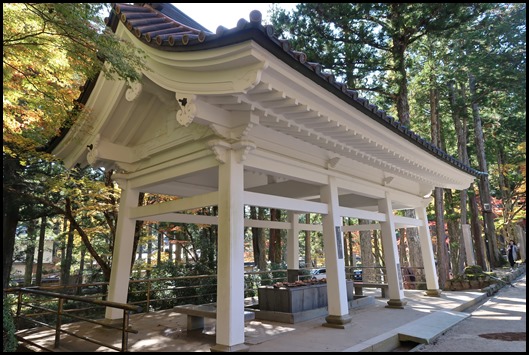 The Mausoleum of Priest Chisen: Priest Chisen (789 – 925) was
born in the Sugawara clan of Old Sanuki Province (Kagawa Prefecture) He was the
nephew of Kobo Daishi Kukai and is known as one of the ten prime disciples,
dedicated to supporting his revered uncle. However, Priest Chisen passed away at
the age of thirty seven in Tonan-in, Kyosan. Kobo Daishi Kukai left a letter
expressing his deep sorrow over his nephews dying so young.
Kyosan was granted to Kobo Daishi as
a place of meditation by Emperor Saga of the Imperial Court in 816. Kobo
Daishi’s wish was to establish a monastery deep in the mountains far from
worldly distractions where Buddhist monks could train and practise Shingon
Buddhism and pray for peace and the welfare of the people. From around the tenth
century, the belief arose that Kobo Daishi Kukai had not passed away, but had
rather entered an eternal meditation at Okunoin for the liberation of all
beings. Faith in Kobo Daishi has sustained generations of people and drawn
pilgrims here for over a millennium.
In 2004, Koyasan was registered as a
UNESCO World Heritage Site as part of the “Sacred Sites and Pilgrimage Routes in
the Kii Mountain Range, and Cultural Landscapes that Surround
Them”.
 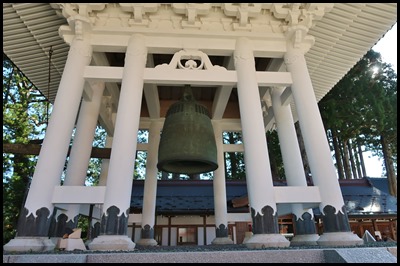 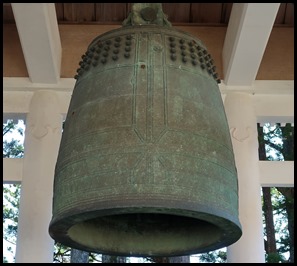 The Bell at the
Great Stupa, Kobo Daishi vowed that he would cast a bell for his
monastery but it was actually his successor Shinzen. Due to the bell tower
having been destroyed by fires, the bell has been recast three times. The
present bell was made in 1547. It is a large bronze bell over two metres in
diameter, having a local nickname of “Koya Shiro.” Every day at 4 am, 1 pm, 5 pm
in winter or 6 pm during the period from the vernal equinox until the autumn
equinox, 9 pm and 11 pm. The bell is struck to announce the time throughout
Koyasan.
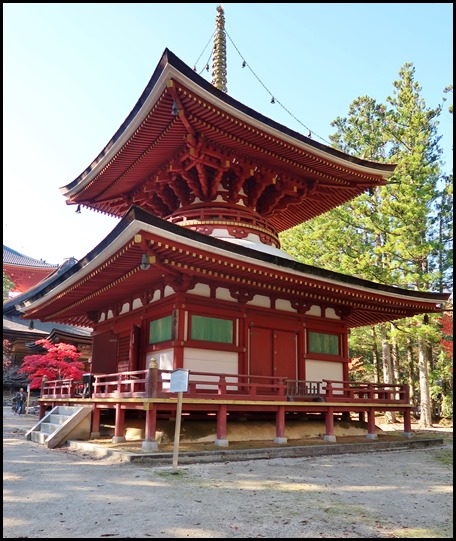 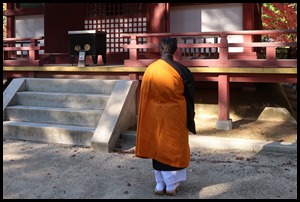 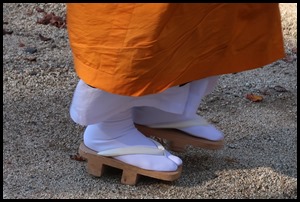 Toto – Eastern
Stupa. At both the eastern and western edges of the Garan there stood a
stupa, but in 1843 a great fire devastated the eastern one, along with what was
known as the Central Gate. Until recently only the cornerstone remained, but
after a one hundred and forty year hiatus it was rebuilt in 1984 as part of the
celebrations of Kobo Daishi’s 1150th memorial, with its graceful shape
embellished in vermillion. The original pagoda was completed in 1127 at the wish
of the retired Emperor Shirakawa. The main deity enshrined is Vikiranosnisa, who
is flanked by the two wrathful deities Acala and Trailokyavijaya. I watched a
lady monk for a moment and enjoyed seeing her totter
away on her traditional flip flops.
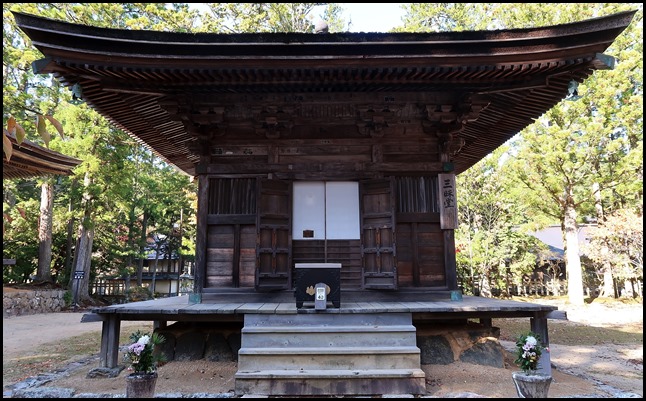 Sanmai-do
(Samadhi Hall), National Historical Site. The poet Saigyo relocated and
constructed this small building here along with the Daiedo in 1177. The name
comes from the fact that the abbot Saiko (9th-10th century) engaged in
meditation (sanmai) here. The main image enshrined inside is that of Dainichi
Nyorai of the Diamond Realm Mandala. The existing structure was rebuilt after
the great fire of 1843. The slope in front of the Daiedo is called the Edo-saka,
and it is said that to the east of the slope Saigyo lived in a temple called
Ryozan-in.
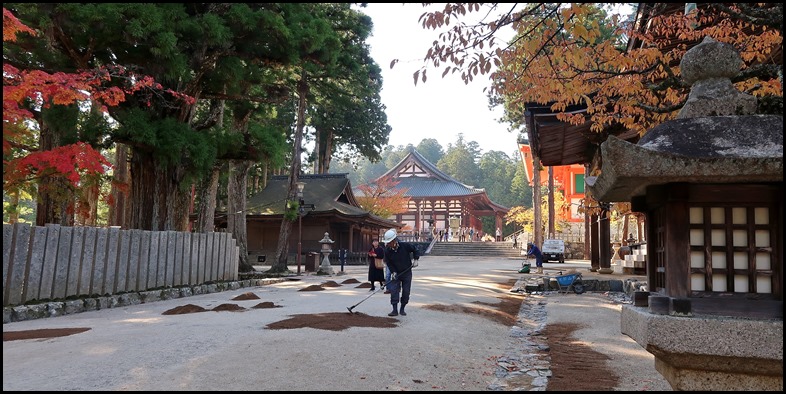 Garan is derived from Sanskrit,
meaning quiet and secluded space and today a few potholes
were being attended to. The first building on the left has a cherry tree
beyond it, it stands in the middle of quite a big space and is known as Saigyo’s
Cherry Tree. The famous monk and poet Saigyo Zakura lived in a hut at Koyasan
for about thirty years from 1149 at the age of thirty- two. He directed the
removal of the Daiedo Hall and Sanmai-do Hall to their present locations and
their reconstruction. When he moved here he personally planted the cherry
tree.
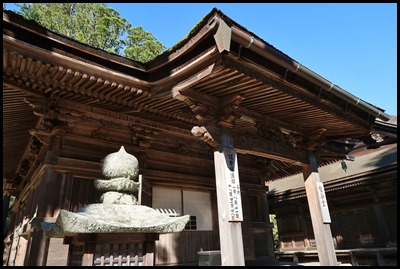 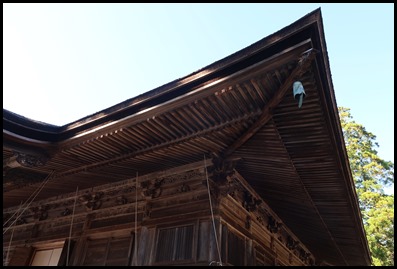 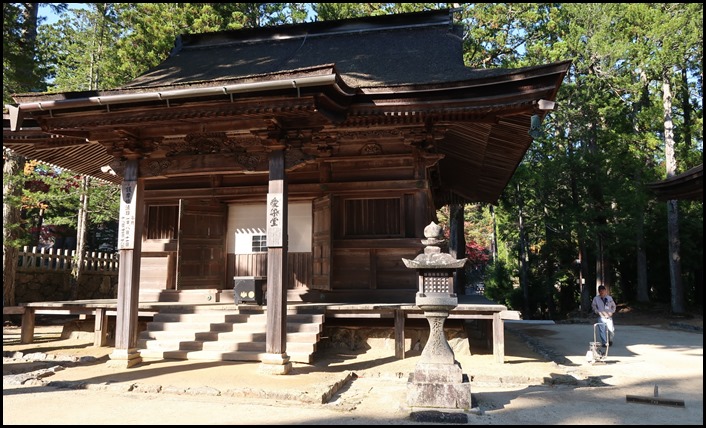 Aizen-do
(Ragaraja Hall), National Historic Site. This structure was constructed at the
wish of Emperor Go-Daigo in 1334. The main deity enshrined is the wrathful deity
Ragaraja, who holds a bow pointing up as if to shoot at the sky, and so is
called the Heaven-Bow Ragaraja. The existing structure was rebuilt after the
1843 fire.
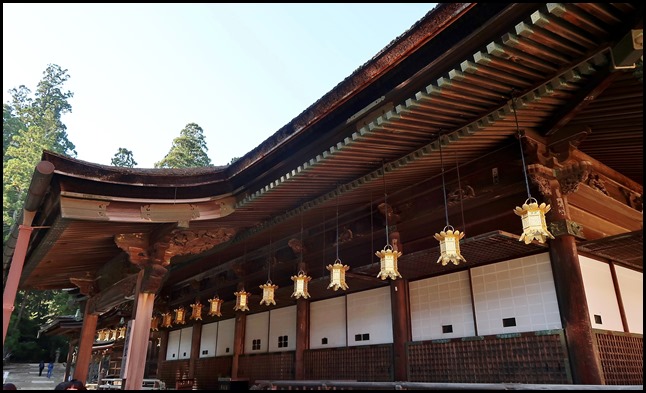 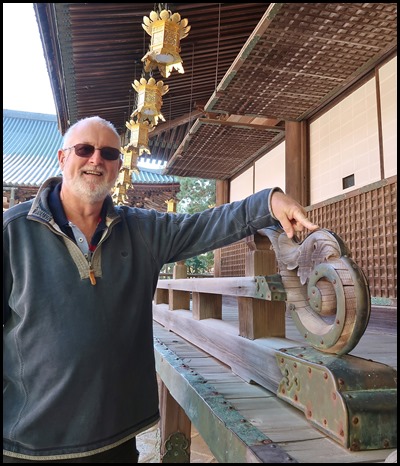 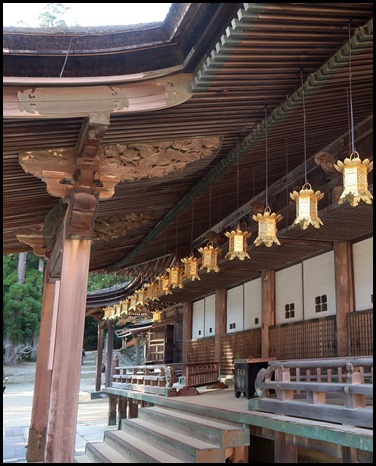 Mieku is
one of the prettiest building in the Garan, lanterns all round and Bear’s
trigger finger twitched at the lovely teak swirl at
the end of the guardrail. The canopy had stunning engraving
at the top of the pillar support.
Every year on the 21st day of the
third month according to the lunar calendar (usually in mid-April), the day of
Kobo Daishi’s passing. The ritual sees the head monk go in to Kobo Daishi and
offers him a change of clothes (at his resting place in Okunoin – the massive
cemetery). All the monks of Koyasan are supposed to gather here at Mieku for an
afternoon service performed according to old custom, the grandest of all
ceremonies.
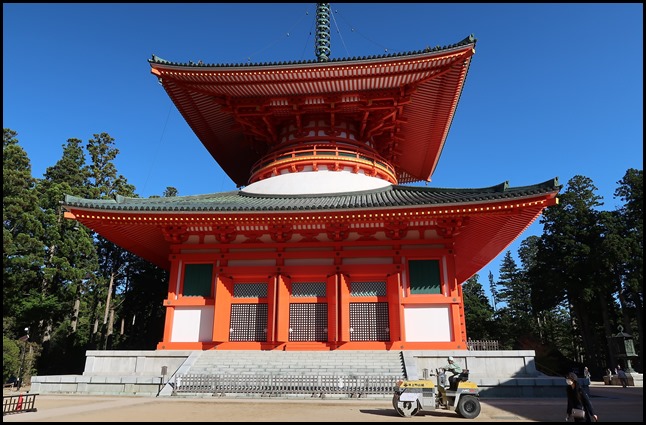 We stood for a while to get a picture
of the Great Stupa or Daito, a) with not too many
people in the picture and b) to have the diddy steamroller just so.
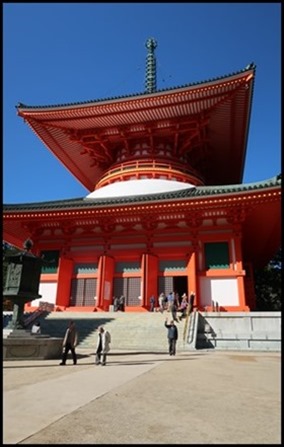 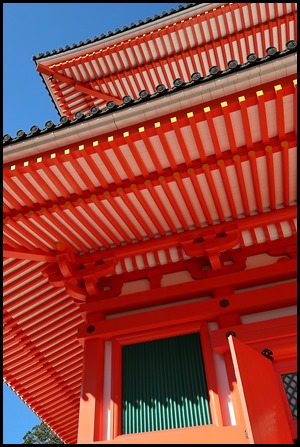 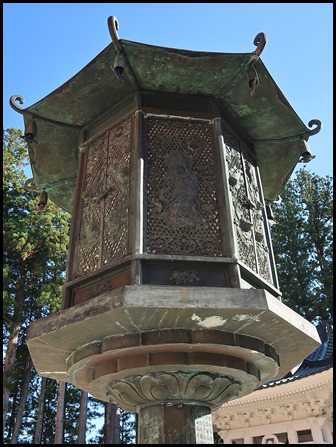 As soon as Kobo Daishi founded the
religious community here at Koyasan, he began construction of the Great Stupa (dwarfing Bear). It is a symbol of the ideals
of Shingon Buddhism, the teaching and practice of Esoteric Buddhism and so is
known as the “fundamental great stupa.” The present structure, the tallest
building in the town, it stands 48.5 metres tall and flares to a majestic 23.5 metres on each of the four sides,
because of the size it took until 876 to complete, over forty years after Kobo
Daishi entered eternal meditation. Architecturally, the Konpon Daito is
classified as an early form of the of the two-storied pagoda. The body of the
pagoda is circular, with a square lower storey with an attached pent roof and
walls.
In later centuries the Konpon Daito
was destroyed in fires caused by lightning strikes five times, and rebuilt each
time. After the great fire of 1843, only the foundation stones remained. The
existing building dates from 1937. The majestic Konpon Daito is today exactly as
it was when it was first constructed, and is known as a symbol of Koyasan. The lantern out front is very ornate.
 The first to be built among the large
structures in the Garan complex, the Kondo is where
Kobo Daishi originally gave religious talks. It has also gone by the names Hall
of Supplication and Hall of the Medicinal Buddha, but at some point became
commonly known as the Kondo, meaning Golden Hall. As a result of the devastating
fire of 1925, the hall’s central Buddha image as well as numerous other figures
designated as National Treasures were lost. The present building dates from 1932
and is the seventh reconstruction. It measures 25 metres in width, 32 metres
deep and 22 metres in height. The central religious image is of Yakushi Nyorai
(The Medicine or Healing Buddha), carved by Takamura Koun but it is not
publically displayed.
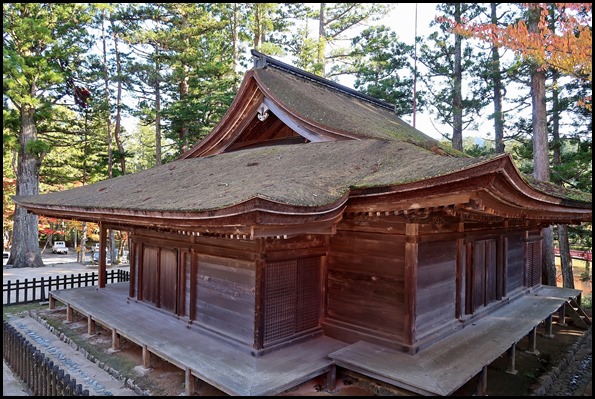 Built in accordance with the wish of
the daughter of the Retired Emperor Toba, Hachijo-nyoin, in 1198, the Fudodo is 13 metres wide, 10.6 metres deep, and in the
style of residential houses of the Heian period. It was moved to this present
location in 1910 for the purpose of repair (from Isshin-in Dani). The main image
enshrined is Fudo Myoo and the Hachidai Doji (eight youthful attendants), all
carved by the famous sculpture Unkei. Fudodo is designated as a National
Architectural Treasure.
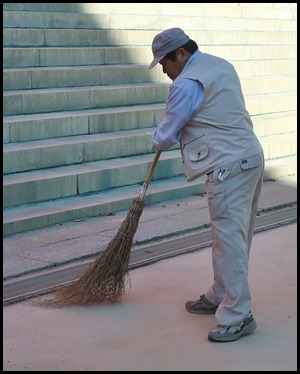 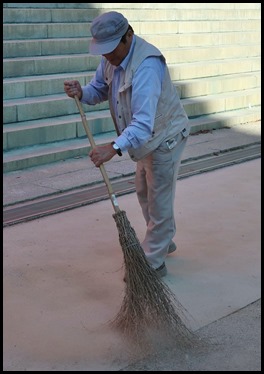 Keeping all spick
and span.
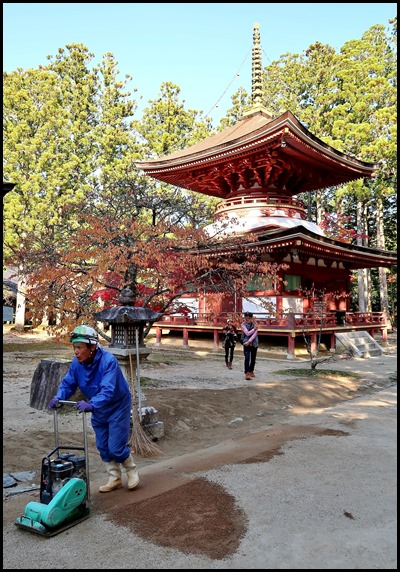  We watched the tamping for a while, enjoyed looking
back at the Great Stupa.
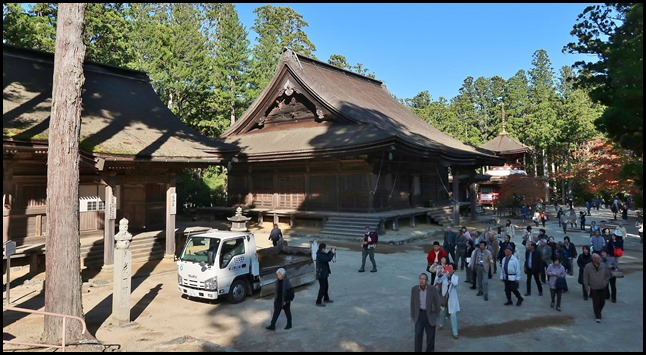 We took in the
Garan.
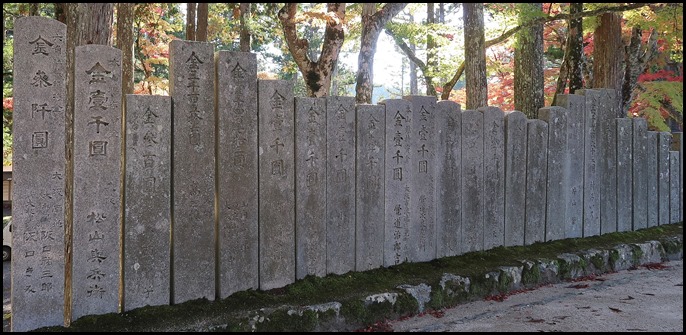 Bimbled by the memorial stones and set off for the cemetery.
ALL IN ALL A BEAUTIFULLY KEPT
SACRED AREA
MANY LOVELY, HOLY SITES IN SUCH A SMALL
AREA |